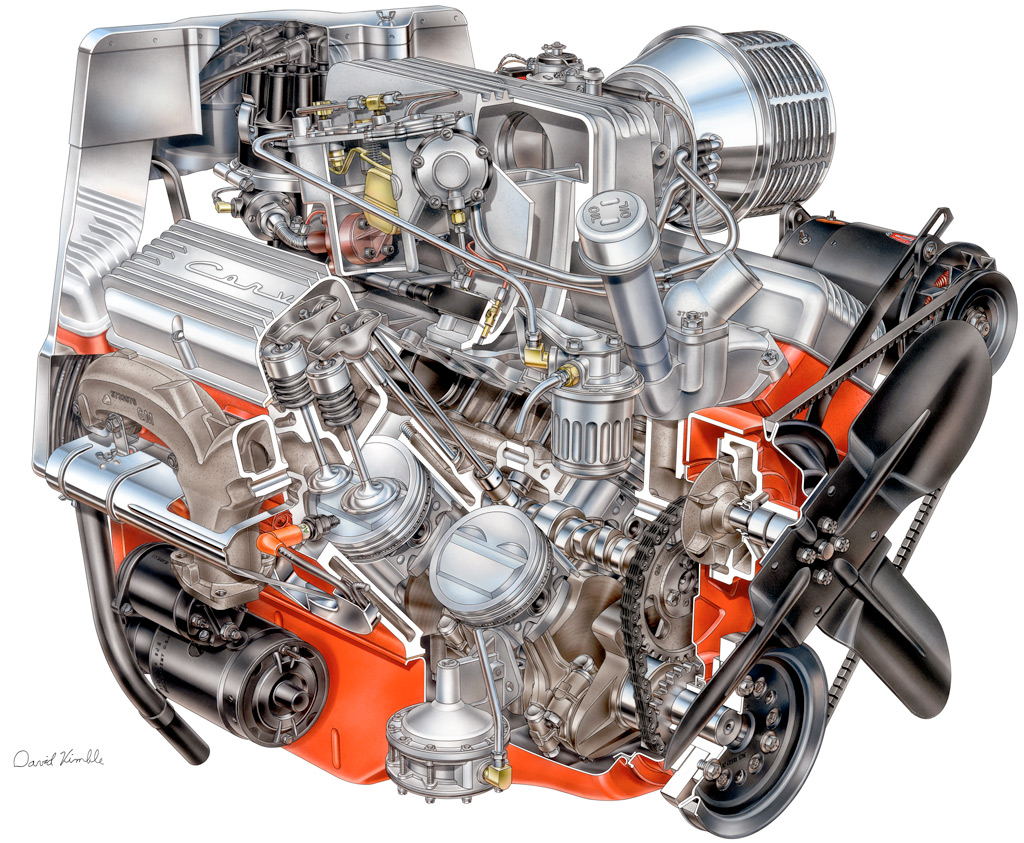 Right: Chevrolet pulled something amazing out of the hat for 1957: Fuel Injection. First run in 1956 at the Sebring race, the Rochester Ramjet injection was an answer to Mercedes-Benz which featured fuel injection in the 1954 300SL. The innovation solved a fuel starvation problem caused by sloshing while cornering with carbureted engines under race conditions. The fuel injection system, displayed in a cutaway drawing above, also enabled Chevrolet to boast of 1 hp per cubic inch of displacement with the 283 cu. in., 283 hp engine.
Right: Chevrolet pulled something amazing out of the hat for 1957: Fuel Injection. First run in 1956 at the Sebring race, the Rochester Ramjet injection was an answer to Mercedes-Benz which featured fuel injection in the 1954 300SL. The innovation solved a fuel starvation problem caused by sloshing while cornering with carbureted engines under race conditions. The fuel injection system, displayed in a cutaway drawing above, also enabled Chevrolet to boast of 1 hp per cubic inch of displacement with the 283 cu. in., 283 hp engine.
To keep this development in perspective, consider this. Almost all of the high priced supposedly advanced competition -- including Jaguar, Porsche, Ferrari and Lamborghini -- did not go with fuel injection until the 1970s or later.
The new system was complex and costly however. At $484.20, the one option added over 15% to the price of an entire Corvette. Buyers found it irresistible however, with 1,040 checking the box on the order form. The complexity also resulted in a high maintenance reputation.
Not up for debate is the way the market treats fuel injected Corvettes of the era. Corvette enthusiasts went for it in a big way in 1957 and more so 50+ years later as a collectable; the price premium for a "Fuelie" as they are often called is significantly higher than their more mundane carbureted cousins.
Above: Fuel Injection as installed in an early Corvette; Below: Later Fuel Injection system on display.
1957 and subsequent Corvettes proudly wore their new technological identities on the front fenders (above) and trunk lids (below).
There was more good go-fast news for Corvette buyers in 1957. Just south of the clutch, a new four speed manual transmission became available as of April 9, 1957. 664 1957 Corvettes were so equipped at an extra cost of $188.30. Special four speeds had been installed in some race cars, so apparently the "More is Better" philosophy applied.
The importance of this development cannot be overstated. A four speed was the ticket to sports car street cred; as of the introduction of the four speed the Corvette started to be take seriously by the high performance sports car community.
Also available in 1957: RPO 684, a racing suspension intended for serious racers. The cost was $780.10 and was installed on only 51 Corvettes in 1957.
Above is a very special fuel injected 1957 Corvette with an airbox intake. It is RPO 579E and only 43 were made. As a racing option, it cost a whopping $726.30 or $242.10 more than the standard fuel injection system.
Special steering column mounted competition mechanical tachometer was part of the package.
Notice the small wheel covers in this 1957 fuelie? It's RPO 276 and was a 15" x 5.5" wheel; stock wheels were 5.0".
The marketing people had started to become aggressive with the competition. This was the start of a series of ads that continued for many years, pointing out that the imports did not entirely own the sports car world.
Convertible Corvette with hardtop (below) and convertible top (above). Buyers actually had a choice of either top as part of a Corvette purchase. If they wanted both, Option Code 419 was selected for an additional $215.20. Thus it was possible to purchase a Corvette with a hard top only.
1957 Corvette interior, in person (above) and per the brochure (below). The seats may appear to be bucket style but were closer to a bench seat in practice. There was no lateral support and the seat back, which was mostly vertical, did not adjust. The comfort level was poor making long trips a challenge. The interior had changed little since the introduction of the 'vette in 1953; the tachometer was still in the center and the other gauges / controls were a long reach. The dashboard was essentially the same as used in other Chevrolet models.
1958 Corvette
1957 Corvette Options



































